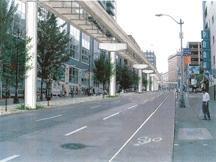Monorail could start here
Cascadia Monorail Co.<br><br>SMALLER MONORAIL COLUMNS. Cascadia is trying to reduce the dimensions of its oval design to 3 feet 6 inches by 4 feet 3 inches. By using thicker steel reinforcements and a different type of concrete, the columns would be able to withstand an earthquake as powerful as any quake in a 2,500-year time span, the company says. This artist's sketch shows what it would look like on Second Avenue, downtown.
Thu, 08/04/2005
West Seattle might get its part of the monorail before the downtown portion is built, and those gigantic support columns may be much smaller, says Cascadia Monorail Co.
Jim Devine, project manager for Cascadia, told the Seattle Monorail Project board of directors it would be quicker and easier to build the monorail in residential neighborhoods because there are fewer utility lines. The downtown section of the monorail would be constructed later.
Devine and Cascadia president Patrick Flaherty told the Seattle Monorail Board last week the first part of the planned monorail system to be built would be the operations center in Interbay, along with a stretch of the guideway as a test section to make sure the rolling stock works properly.
The West Seattle and Ballard sections would be next, Devine said.
Cascadia engineers also are evaluating the Seattle Monorail Project's plan for a single-beam guideway along the center of the West Seattle Bridge. Devine said they are confident the bridge structure could support a dual-beam guideway, which would allow more than one monorail train crossing the bridge at a time.
"The question is, can the foundations handle it," he said, especially when two trains pass next to each other.
Cascadia is trying to reduce the dimensions of its oval design to 3 feet 6 inches by 4 feet 3 inches, Devine said.
By using thicker steel reinforcements and a different type of concrete, the columns would be able to withstand an earthquake as powerful as any quake in a 2,500-year time span, Devine said.
Before the columns are installed, crews would paint an oval on sidewalks where each column is planned so that people could see where the columns would stand and how they might affect the neighborhoods, Devine said.
Monorail board member Richard Stevenson questioned the wisdom of building columns strong enough to withstand a 2,500-year earthquake when records indicate the Seattle area has never had a temblor stronger than a 500-year earthquake. The longer the time period, the greater the chance earthquakes could occur.
Cascadia Monorail Co. is comprised of about 20 separate construction and transportation businesses that came together as the only bidder for the contract to design and build the monorail. They also would operate and maintain the Green Line for at least its first five years in service.
Flaherty told the monorail board that the Fluor Corp., one of the biggest players in Cascadia, guarantees a fixed price on the contract and "the risk is transferred to the contractor (Fluor)."
Payments to Cascadia would be based on its progress through construction, with a penalty of $35,000 for every day the project is late
"Whatever it costs, we will have the responsibility to build it," Flaherty said.
No contract has yet been signed between Cascadia with the Seattle Monorail Project, but the consortium was the only bidder. Mid-December is the deadline to make a deal.
Cascadia officials plan to build support columns with an oval circumference. Most columns would be less than half as wide as those supporting the existing monorail on Fifth Avenue, Devine said. The columns would be five times stronger than the columns that support the Las Vegas monorail and 17 times stronger than the columns on Seattle's existing monorail, he said.
Some stations will be designed so that, in the future, they could serve as transfer points to new monorail lines. The Market Street station is slated as a transfer point as well as an undetermined station in the Sodo area. Each terminus station, Morgan Junction and Crown Hill, also will be transfer stations.
The average cost of a monorail station is estimated at $8 to $10 million. Meanwhile the showpiece $15 million station would be at Seattle Center.
Regarding station design. Cascadia approach is to try out four or five different types of stations at each location to see which models work best at each site.
Cascadia architects would prepare a list of "elements of distinction" such as canopies, murals, lighting and color combinations. The public would choose features for each station like a shopper selecting features for a new car. Effort would be made to differentiate stations so the Green Line would be coordinated, Devine said.
Devine said the design process is only 5 to 10 percent completed and Cascadia, if it gets a signed contract, would regularly consult with the public and adjust its plans at various stages of what is expected to be a two-year design process.
The consortium of private companies plans to base its design on comments previously collected during Seattle Monorail Project public workshops and meetings.
"We will take their comments and we will make tradeoffs," Devine said. "We cannot do this project without public input."
Tim St. Clair can be contacted at 932-0300 or tstclair@robinsonnews.com


